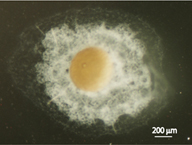ABOUT SPONGES
About the freshwater sponge Ephydatia fluviatilis
Sponges are the sister group of the eumetazoa (cnidarians and bilaterians). So we can learn from sponges not only about their own mechanisms of development but also about the evolution of, and the origin of, the developmental mechanisms of animals in general.
Ephydatia fluviatilis belongs to the demosponges, the largest sponge class which includes almost 90% sponge species. Since Ephydatia (E. fluviatilis and E.Muelleri) are cosmopolitan and have an efficient asexual reproduction system, known as gemmule hatching, both species have been used for decades for cell biological and histological studies. In the past10 years, molecular studies of Ephydatia have been increasing.
| Like most freshwater sponges, E. fluviatilis forms small particles known as gemmules in their tissue. Thousands of resting stem cells (thesocytes) are packed inside the gemmule coat and when gemmule hatching is started, thesocytes activated to become active stem cells (archeocytes) and migrate out from the gemmule coat and then form a functional juvenile sponge within 7-10 days. So, they provide wonderful system to clarify the molecular and cellular mechanisms that regulate the stem cell system in sponges and also that regulate the body plan for constructing their body. |  |

